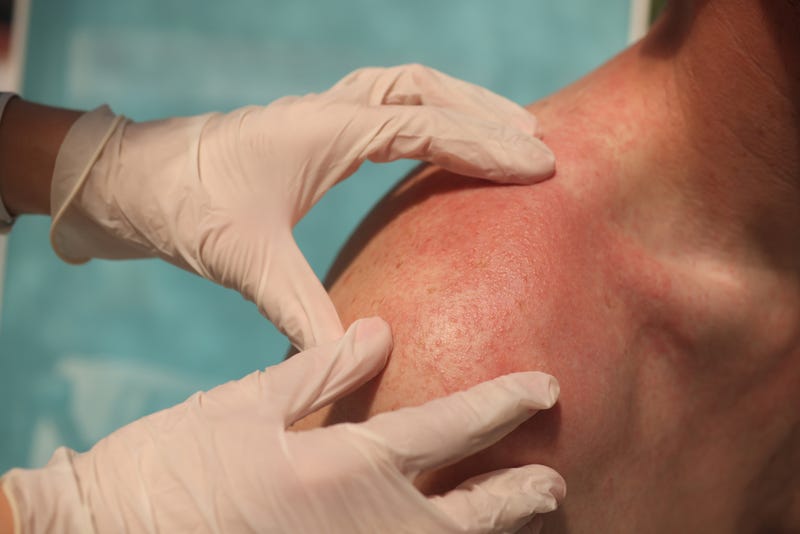
We might have endlessly long winters in Minnesota, but that hasn’t stopped the state from having one of the highest rates of melanoma in the country. A new study says Utah, Vermont and here in the North Star State they’re seeing the highest rates of skin cancer per 100,000 people.
According to the Minnesota Department of Health, cases of melanoma have more than tripled in the state since 1988, for both males and females.
It might be those long winters that are to blame, as Minnesotans flock to the sunshine and heat over the summer months. But dermatologists like Dr. Charles Crutchfield are warning people to take care of their skin.
Crutchfield, of Crutchfield Dermatology in Eagan, says it is very important to use sunscreen and to use it properly.
“There's been a lot of concern about benzene containing products, and when you look at it, most products you buy contain low levels of benzene,” says Crutchfield. “So what I recommend on that is don't use any aerosolized sunscreens. Use sunscreens that you apply directly. As one of my mentors said at the University of Minnesota where I trained in residency in dermatology, the best sunscreen is the one that gets used. So you want something that people like so it doesn't leave a white pasty film. It doesn't smell bad. It's not sticky.”
Crutchfield says that he has no financial interest in sun care products but he does recommend Neutrogena Hydro Boost.
“It goes on thin, it gives great coverage and it doesn't smell bad,” he says. “It's one that my daughter likes and she's very picky.”
The other thing Crutchfield said you can stop worrying about is the SPF number. He says that number doesn’t mean nearly as much as some other qualities you should be looking at when picking a sunscreen.
“People are always focused in on this SPF number,” Crutchfield told WCCO’s Vineeta Sawkar. “That means very little. The SPF number just tells about how long you can stay out in the sun before you get a burn. So the way I look at, and this is not quite right, but for UVB radiation, B is for burns. UVA is for aging, brown spots, wrinkles and skin cancer. So if you're really trying to protect against skin cancer, you need a sunscreen that's broad spectrum. It's got helioplex or broad spectrum. That's the most important thing. It's much more important than the SPF number.”
He recommends one with an SPF of 30 or higher to give you plenty of sun time before you burn, and one that is broad spectrum.
The other big tip from Crutchfield is to make sure you put it on before you head outside.
“Apply it 20 minutes before you leave the house because it takes 15 minutes to set up in your skin,” Crutchfield explains. “So many times I've gone to the beach and I see people lay out there. They lay out their towel, they get their drinks, and they get their book ready. Then they put their sunscreen on. Well now they've had 20 minutes of exposure they didn't need to.
Crutchfield adds that you should reapply it frequently, at least every one to two hours, especially if you're perspiring or swimming. He also says sun-protected clothing can really help.
“There are great companies,” Crutchfield says about sun-protected clothes. “There's one based in Minnesota called Coolibar, which is the name of a shade tree in Australia. The guy is from Australia. But once you put that on, it's light, it's vented, you don't even know you're wearing it. I combine those two things for great sun protection.”
When it comes to skin cancer, Crutchfield says there are three kinds you need to watch out for.
“Basal cell carcinoma, squamous cell carcinoma and melanoma,” explains Crutchfield. “Basal cell skin cancer is the most common malignancy in the world and there are about a million cases diagnosed in the United States every year. Those rarely metastasize, to go deep. But locally, they can be destructive. You can get infections and have problems with that. Squamous cell is the second most common, but the most worrisome is melanoma. And that's what you're talking about. In the United States, there are about 30,000 cases diagnosed every year. But the key is to get it early. Like any malignancy, you want to catch it early. That has the best chance of survival. So what I tell my patients, if you have a family member, first degree family member with a skin cancer, you need to see a dermatologist and get a baseline exam.”
Crutchfield says if you notice it moles changing in any way, size, color, shape, elevation, or if it bleeds and doesn't heal on its own in three weeks without provocation, you should be getting it checked by a dermatologist.
“If you're shaving and it bleeds, that doesn't matter," says Crutchfield. “If you're washing with a cotton wash cloth and it starts bleeding, that's a big deal. So I tell my patients, if it changes, see a board certified dermatologist. Let them take it from there.”


